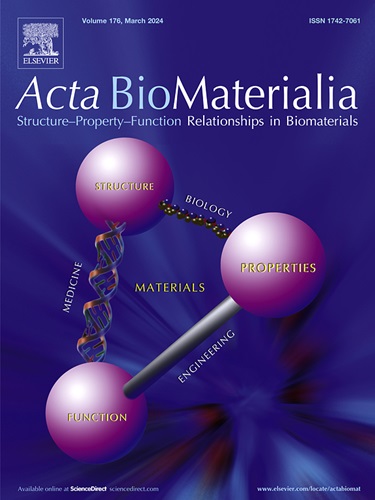A promising strategy for ocular noninvasive protein delivery: The case in treating corneal neovascularization
IF 9.4
1区 医学
Q1 ENGINEERING, BIOMEDICAL
引用次数: 0
Abstract
Current clinical treatment of corneal neovascularization (CNV), a leading cause of visual impairment worldwide, by a class of glucocorticoids suffers from the ineffective and numerous adverse effects. Bevacizumab (Beva), an anti-neovascularization protein, is a promising therapeutic option but limited by subconjunctival injection due to its poor penetration across ocular bio-barriers, which significantly reduces patient compliance and increases the risk of infection. Herein, a CmA@Beva nanomedicine was developed, based on the co-assembly of novelly designed peptide, (Cysteine-Histidine-Arginine)3, with Beva in the presence of Zn2+. The conditions for the formation of CmA and encapsulation of Beva in CmA were optimized, and the pH-responsive release of Beva and the protective effects of CmA@Beva on Beva were explored. In vitro and in vivo studies showed CmA@Beva exhibited good biocompatibility and demonstrated notable improvements in Beva retention time in the anterior eye segment. CmA@Beva eye drops could overcome corneal bio-barriers by opening ocular surface tight junctions and the endocytosis-lysosomal escape pathway, which together resulted in a therapeutic outcome on rat CNV superior to subconjunctival injection. The present study contributes to the development of a noninvasive protein drug delivery strategy for the treatment of CNV or other diseases of the eye anterior segment.
Statement of significance
Corneal neovascularization (CNV) has been recognized as the leading cause of vision impairment globally, affecting approximately 1.4 million people each year. Protein drugs have shown high specificity and low side effect in disease treatment compared to small molecule drugs. However, limited ability to cross ocular barriers remain a big challenge. Here, a nanomedicine (CmA@Beva) was employed to address this issue through exampling on an anti-neovascularization protein, bevacizumab (Beva). CmA@Beva enhances retention on the ocular surface and effectively delivers Beva across the epithelial barrier, and thus is much more effective than the commonly used subconjunctival injections used for treatment in the clinic. This may be a good strategy for non-invasive delivery of protein drugs for the treatment of anterior segment diseases.

一种有前途的眼部无创蛋白递送策略:治疗角膜新生血管的案例。
角膜新生血管(CNV)是世界范围内视力损害的主要原因之一,目前临床使用的一类糖皮质激素治疗效果不佳且不良反应众多。贝伐单抗(Bevacizumab, Beva)是一种抗新生血管蛋白,是一种很有前景的治疗选择,但由于其穿透眼生物屏障的能力差,因此受到结膜下注射的限制,这大大降低了患者的依从性并增加了感染的风险。本文基于新设计的肽(半胱氨酸-组氨酸-精氨酸)3与Beva在Zn2+存在下的共组装,开发了CmA@Beva纳米药物。优化了CmA的形成条件和Beva在CmA中的包封条件,并探讨了Beva的ph响应性释放和CmA@Beva对Beva的保护作用。体外和体内研究表明CmA@Beva具有良好的生物相容性,并能显著改善Beva在前眼段的滞留时间。CmA@Beva滴眼液可以通过打开眼表紧密连接和胞吞-溶酶体逃逸途径来克服角膜生物屏障,这两者共同导致大鼠CNV的治疗效果优于结膜下注射。本研究有助于开发一种治疗CNV或眼前段其他疾病的无创蛋白药物递送策略。重要意义:角膜新生血管(CNV)已被公认为全球视力损害的主要原因,每年影响约140万人。与小分子药物相比,蛋白质药物在疾病治疗中表现出高特异性和低副作用。然而,有限的穿越眼障的能力仍然是一个很大的挑战。在这里,纳米药物(CmA@Beva)通过抗新生血管蛋白贝伐单抗(Beva)的例子来解决这个问题。CmA@Beva增强了在眼表面的滞留,并有效地将Beva传递过上皮屏障,因此比临床上常用的结膜下注射治疗有效得多。这可能是一种治疗前节段疾病的无创蛋白药物递送的好策略。
本文章由计算机程序翻译,如有差异,请以英文原文为准。
求助全文
约1分钟内获得全文
求助全文
来源期刊

Acta Biomaterialia
工程技术-材料科学:生物材料
CiteScore
16.80
自引率
3.10%
发文量
776
审稿时长
30 days
期刊介绍:
Acta Biomaterialia is a monthly peer-reviewed scientific journal published by Elsevier. The journal was established in January 2005. The editor-in-chief is W.R. Wagner (University of Pittsburgh). The journal covers research in biomaterials science, including the interrelationship of biomaterial structure and function from macroscale to nanoscale. Topical coverage includes biomedical and biocompatible materials.
 求助内容:
求助内容: 应助结果提醒方式:
应助结果提醒方式:


